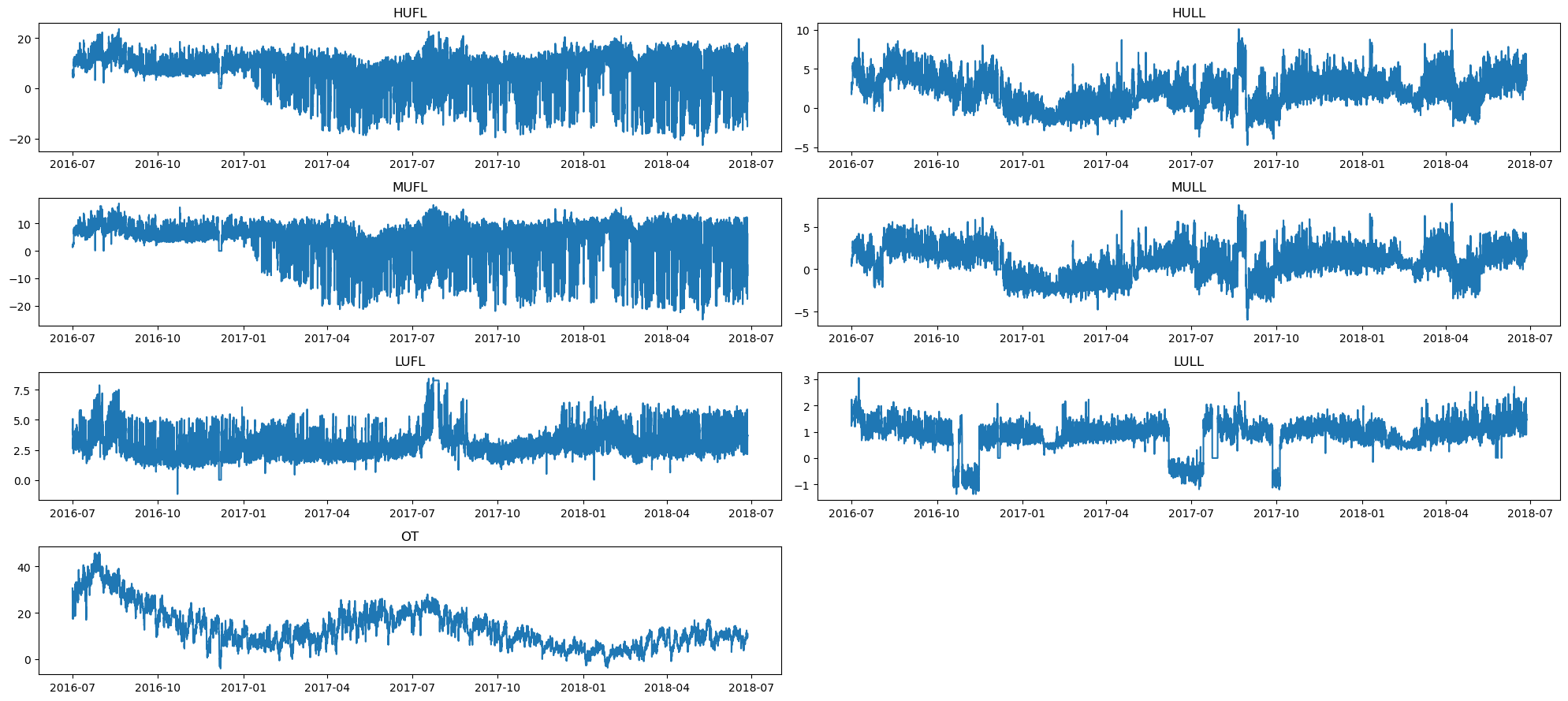Electricity Transformer Temperature#
概要
電力変圧器温度に関する多変量時系列データセット。中国の2つの地区で、2年間取得されている。いずれも目的変数の"oil temperature"と、ほかの6つの特徴量が含まれている。
オリジナルデータ: GitHub
データ形式:
.csvタスク: 時系列予測
データスペック#
- データ長:
2年間
- 特徴量次元:
7 (うち
oil temperatureが目的変数)- サンプリング間隔:
ファイル名の
1と2はデータ収集場所の違いETTh1.csv,ETTh2.csvは1時間ごとETTm1.csv,ETTm2.csvは15分ごと
- バリデーション:
元論文(Informer)中では、Train/Vaild/Testを、それぞれ12/4/4ヵ月に分割して使用
カラム名#
csvファイルに格納されているカラム名の略記一覧
Field |
date |
HUFL |
HULL |
MUFL |
MULL |
LUFL |
LULL |
OT |
|---|---|---|---|---|---|---|---|---|
Description |
The recorded date |
High UseFul Load |
High UseLess Load |
Middle UseFul Load |
Middle UseLess Load |
Low UseFul Load |
Low UseLess Load |
Oil Temperature (target) |
可視化#
前述のGitHubリポジトリからデータをダウンロードしていることとします。
ここではcsvファイルを ../data/ETT-small に配置したと想定して可視化します。また、ETTh1のみを例示します。
ライブラリ群の読み込み (折りたたみ)#
Show code cell source
from pathlib import Path
import numpy as np
import matplotlib.pyplot as plt
import pandas as pd
import seaborn as sns
import plotly.graph_objects as go
from plotly.subplots import make_subplots
import plotly.io as pio
import plotly.express as px
import plotly.offline as py
from plotly_resampler import FigureResampler
pio.renderers.default = 'plotly_mimetype+notebook'
データ読み込み#
rootdir = Path('../data/ETT-small')
ETTh1 = pd.read_csv(rootdir/'ETTh1.csv', index_col=0, parse_dates=True)
ETTh2 = pd.read_csv(rootdir/'ETTh2.csv', index_col=0, parse_dates=True)
ETTm1 = pd.read_csv(rootdir/'ETTm1.csv', index_col=0, parse_dates=True)
ETTm2 = pd.read_csv(rootdir/'ETTm2.csv', index_col=0, parse_dates=True)
ETTh1.head()
| HUFL | HULL | MUFL | MULL | LUFL | LULL | OT | |
|---|---|---|---|---|---|---|---|
| date | |||||||
| 2016-07-01 00:00:00 | 5.827 | 2.009 | 1.599 | 0.462 | 4.203 | 1.340 | 30.531000 |
| 2016-07-01 01:00:00 | 5.693 | 2.076 | 1.492 | 0.426 | 4.142 | 1.371 | 27.787001 |
| 2016-07-01 02:00:00 | 5.157 | 1.741 | 1.279 | 0.355 | 3.777 | 1.218 | 27.787001 |
| 2016-07-01 03:00:00 | 5.090 | 1.942 | 1.279 | 0.391 | 3.807 | 1.279 | 25.044001 |
| 2016-07-01 04:00:00 | 5.358 | 1.942 | 1.492 | 0.462 | 3.868 | 1.279 | 21.948000 |
ETTh1.describe()
| HUFL | HULL | MUFL | MULL | LUFL | LULL | OT | |
|---|---|---|---|---|---|---|---|
| count | 17420.000000 | 17420.000000 | 17420.000000 | 17420.000000 | 17420.000000 | 17420.000000 | 17420.000000 |
| mean | 7.375141 | 2.242242 | 4.300239 | 0.881568 | 3.066062 | 0.856932 | 13.324672 |
| std | 7.067744 | 2.042342 | 6.826978 | 1.809293 | 1.164506 | 0.599552 | 8.566946 |
| min | -22.705999 | -4.756000 | -25.087999 | -5.934000 | -1.188000 | -1.371000 | -4.080000 |
| 25% | 5.827000 | 0.737000 | 3.296000 | -0.284000 | 2.315000 | 0.670000 | 6.964000 |
| 50% | 8.774000 | 2.210000 | 5.970000 | 0.959000 | 2.833000 | 0.975000 | 11.396000 |
| 75% | 11.788000 | 3.684000 | 8.635000 | 2.203000 | 3.625000 | 1.218000 | 18.079000 |
| max | 23.643999 | 10.114000 | 17.341000 | 7.747000 | 8.498000 | 3.046000 | 46.007000 |
プロット (Plotly)#
fig = make_subplots(rows=7, shared_xaxes=True, vertical_spacing=0.04, subplot_titles=ETTh1.columns)
fig = FigureResampler(fig)
idx = ETTh1.index
for i, col in enumerate(ETTh1.columns):
fig.add_trace(go.Scattergl(x=idx, y=ETTh1[col], name=col),
row=i+1, col=1)
fig.update_layout(autosize=True, height=1000, margin=dict(l=20, r=20, t=20, b=10), showlegend=False)
fig.show()
補足: matplotlibの場合#
Show code cell content
import math
def plot_ts(df: pd.DataFrame, n_split=2, dpi=100):
n_col = len(df.columns)
fig = plt.figure(figsize=(20, n_col//n_split*3), dpi=dpi)
x_idx = df.index
for i, c in enumerate(df.columns):
ax = fig.add_subplot(math.ceil(n_col/n_split), n_split, i+1)
ax.set_title(c)
ax.plot(x_idx, df[c])
plt.tight_layout()
plt.show()
plot_ts(ETTh1)

参考文献#
Zhou, Haoyi, et al. "Informer: Beyond efficient transformer for long sequence time-series forecasting." Proceedings of the AAAI Conference on Artificial Intelligence. Vol. 35. No. 12. 2021.

